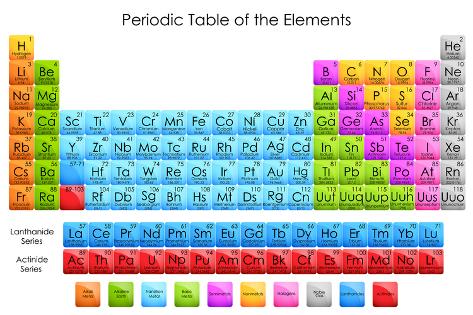

The separated hafnium is used for control rods. The resulting reactor-grade zirconium is about 10 times as expensive as the hafnium-contaminated commercial grade.

Two main process are in use: liquid-liquid extraction, exploiting the difference of solubility of metal thiocyanates in methyl isobutyl ketone, used mainly in United States, and extractive distillation, used primarily in Europe. This removal process is difficult (zirconium and hafnium are two of the most difficult elements to separate). Commercial zirconium naturally contains 1-5% of hafnium which has to be removed.
#Periodic table chemistry zr free#
Reactor-grade zirconium alloys must be made of purified zirconium free of hafnium contamination, as hafnium has very high neutron absorption cross-section, 600 times higher than zirconium. Zirconium is also applied in the molecule Aluminium Zirconium Octachlorohydrex GLY, also known as Anti-perspirant.Zirconium is also used in the manufacture of high strength lacrosse sticks. This combination provides the frame with tougher durability likewise, the frame becomes lighter and much stronger. Bicycle manufacturers incorporate zirconium- aluminium alloys in their high end bicycle frames.Bis(cyclopentadienyl)zirconium(IV) chloride hydride ( Schwartz's Reagent) is a commercially available metallocene used in the hydrozirconation of alkenes and alkynes.Both coatings are supposed to keep the bit sharper and cooler during cutting. Zirconium nitride has been used more recently as an alternative to titanium nitride for coating drill bits.Zirconium Diamide-Diamine complexes can be used to catalyse the polymerisation of alkenes, especially ethene, when activated with Trityl-BArF.When alloyed with niobium, zirconium becomes superconductive at low temperatures and is used to make superconductive magnets with possible large-scale electrical power uses.Also used in heat exchangers, as a " getter" in vacuum tubes, in lamp filaments and various specialty alloys.Human tissues can easily tolerate this metal which makes it suitable for biocompatible implants, eg.Impure zirconium oxide, Zirconia, is used to make laboratory crucibles that can withstand heat shock, for linings of metallurgical furnaces, and by the ceramic and glass industries as a refractory material.Its carbonate was used in poison-ivy lotions until it was evident that many people are allergic.It is also planned for use in the baseline variant of the AGM-154 Joint Standoff Weapon for incendiary effects. Zirconium is pyrophoric (flammable) and has been used in military incendiaries such as Dragon's Breath.Extensively used by the chemical industry for piping in corrosive environments.Reactor-grade zirconium has to be purified of hafnium, which has 600 times higher neutron cross-section a hafnium-free zirconium can be 10 times more expensive than zirconium with naturally occurring 1-5% of hafnium. Modern commercial scale reactors can use as much as a 150,000 meters of zirconium alloy ( Zircaloy) tubing. More than 90% of zirconium metal production is consumed by commercial nuclear power generation. Zirconium has a low absorption cross section for thermal neutrons, which makes it ideal for nuclear energy uses, such as cladding fuel elements.Zircon is also marketed as a natural gemstone used in jewelry, and its oxide is processed to produce the diamond simulant, cubic zirconia (shown at left). The major end uses of zircon (Zr Si O 4) are refractories, foundry sands (including investment casting), and ceramic opacification. Oxidation state of zirconium is usually +4, although +3 and +2 can also be obtained. Zirconium zinc alloy becomes magnetic at temperatures below 35 K. When it is finely divided, the metal can spontaneously ignite in air, especially at high temperatures (it is much more difficult to ignite the solid metal). Zirconium is lighter than steel and its hardness is similar to copper. = Notable characteristics It is a grayish-white metal, lustrous and exceptionally corrosion resistant. Zirconium is primarily used in nuclear reactors due to its resistance to corrosion and low neutron cross-section. A lustrous gray-white, strong transition metal that resembles titanium, zirconium is obtained chiefly from zircon and is very corrosion resistant. Zirconium ( IPA: /zəˈkəʊniəm, ˌzɛːˈkəʊniəm/) is a chemical element in the modern periodic table that is assigned the symbol Zr and has the atomic number 40.


 0 kommentar(er)
0 kommentar(er)
